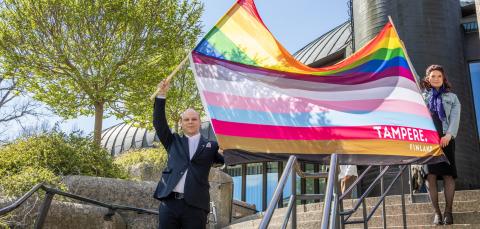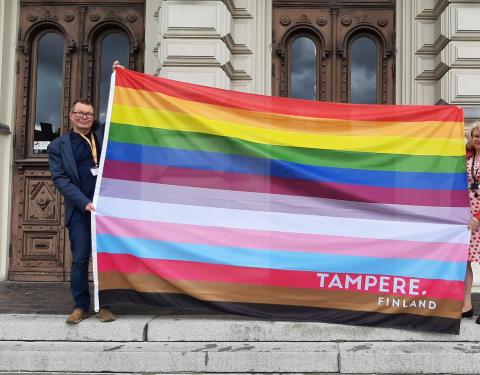Sexual and gender minorities

There has always been diversity of sexuality and gender. The majority of the population identifies as heterosexual men or women. However, an estimated 5–15 % of the population considers themselves part of sexual and gender minorities. In Tampere, this minority, known as rainbow people, includes 13 000–39 000 residents.
Rainbow people are present throughout society: in all age, cultural, linguistic, religious, disability and political groups, in all professions and in all economic and social groups.
Despite their prevalence, rainbow people are an invisible identity group. They become visible only when they have personally disclosed their identity to others. Society must be a safe and sensitive place where everyone can share their identity. No one should be required to be brave to be themselves.
Rainbow people
Sexual and gender minorities include, for example, asexual, bisexual, homosexual, pansexual, transgender, transvestite and non-binary people who do not identify as male or female. These sexual and gender minorities are often referred to as rainbow people.
Rainbow people can also be referred to by the acronym HLBTIQA+, which is the Finnish version of the English acronym LGBTIQA+. The Finnish acronym is formed from the words homo, lesbo, biseksuaali, trans-ihminen, intersukupuolinen, queer/questioning and aseksuaali. The “+” at the end of the abbreviation indicates that the list is not exhaustive. Many identities are not mentioned in it.
Laws prohibit discrimination
Equality and non-discrimination laws prohibit discrimination on grounds such as sexual orientation, gender or gender expression, gender identity or family structure.
It was only in the 2000s that changes in the law and the general attitude climate made it possible to speak positively about belonging to sexual minorities and different gender identities.
Despite this, many people belonging to sexual and gender minorities still face discrimination, hate speech and negative attitudes. Many have to hide their identity for safety reasons in their communities, hobbies, workplaces and public services. They have no opportunity to be recognized as themselves and, for example, use their preferred name, express the gender they feel is right, or openly talk about their relationships or family structure.
Society must act to dismantle structural discrimination and enable everyone to be naturally themselves. This will reduce minority stress and fear of discrimination.
Tampere for all
The City of Tampere does not tolerate discrimination. The aim is that everyone – including those from sexual and gender minorities – can feel accepted and use the city's services without fear of being treated inappropriately.
Many of the city's services have established safer space principles. These are displayed in customer areas and on websites and they are reviewed at the beginning of various events. The safer space principles signify that the staff values diversity and does not tolerate inappropriate behavior from anyone. The principles also include accessibility and inclusivity information, such as the availability of unisex toilets.
Tampere Pride flag
Tampere has implemented its own pride flag. Its 13 colour stripes broadly reflect the different identity groups of the rainbow population. The city will fly its own pride flag during Manse Pride week, among other events.

The long rainbow history or Tampere
Tampere has a long and diverse subculture where members of sexual and gender minorities have been able to meet each other.
Most of these meetings took place unnoticed by the majority population, for example, in parks, at the railway station or in public restrooms. However, Tampere has had artists, especially in the fields of theater and literature, who have relatively openly expressed their gender and sexual identities. They have been pioneers who have influenced the attitudes of Tampere residents.
In 1973, Vagabondi ry was founded in Tampere, bringing together people belonging to sexual and gender minorities. The association has changed its name several times, and today it is known as Sinuiksi ry. The association has a nationwide counselling service which, as the name suggests, supports people in becoming more in tune with themselves.
Over the years, the association has organized several major events that have been significant for both the residents of Tampere and the rainbow community coming from nearby or further away. Over the years, the association has organized several major events that have been For example, Leimautumispäivät, the national Vapautuspäivät, and the Tampere Pride event in 2005 have been the first opportunities for many to come out and feel accepted as themselves.
Information about the subculture of sexual and gender minorities in Tampere has been compiled in the social history dissertation by docent Tuula Juvonen, titled "Varjoelämää ja julkisia salaisuuksia" (2002).
Tampere also has the Workers' Museum Werstas, which nationally preserves not only the history of the Finnish labor movement but also social history related to sexual and gender minorities.
Rainbow communities in Tampere
- Sinuksi ry (diverse group activities for different rainbow groups, national counselling service)
- Sateenkaariperheet ry (national association with a local group in Tampere)
- Transfeminiinit ry (national association with a local branch in Tampere)
- Mummolaakso ry (national association with a local group in Tampere)
- Sateenkaariseniorit ry (national association with a local group in Tampere)
- Polyamoria ja monisuhteisuus ry (national association with a local group in Tampere)
- Nuorisotila Kaareva (rainbow activities in the city of Tampere for 13-29 year olds)
- Sateenkaarihistorian ystävät ry (rainbow history research and events)